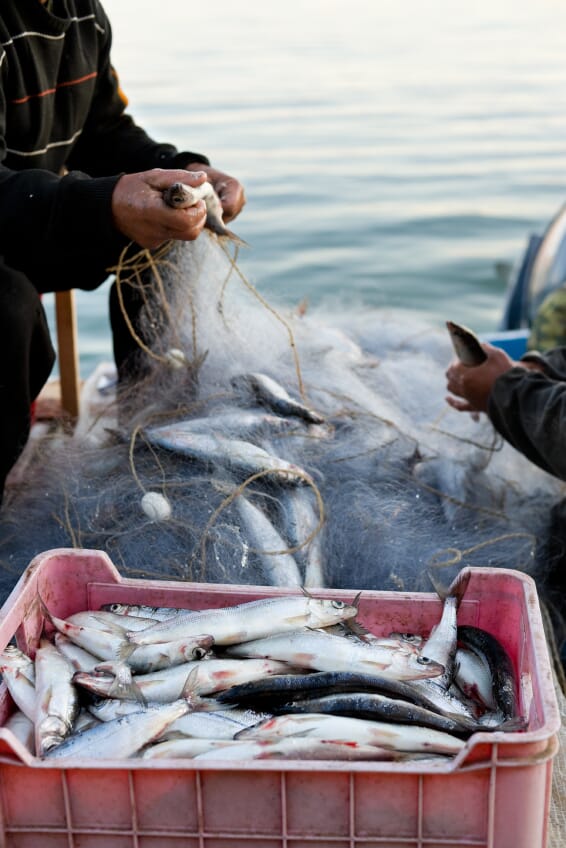Under the old rules, when quota for a particular species was reached, as would occur where a species with a low quota was a component of a mixed-stock fishery or indeed in a fishery with high levels of bycatch, any further catch of that species was simply thrown away.
Fishing operations would continue until the quota for all species was fulfilled. Now discarding is effectively banned, once quota for one species is hit, fishers could be forced to discontinue operations or risk exceeding quota limits - even though they may still have unused quota for other species. 
The methods for dealing with these “choke species” has largely been left down to individual fisheries to decide. Certainly the landing obligation presents a complex issue. With concern surrounding the socio-economic ramifications on fishers and fishing communities throughout Europe, avoiding choke species is high up on the agenda.
Gear Improvements
Unwanted catch arises in part from the lack of selectivity in fishing gear. Over the years, various legislation has been brought in to improve the selectivity of gear – minimum mesh sizes to allow more undersized individuals to escape nets and turtle excluder devices to allow sea turtle to escape trawls, for example.
There are limits to what can be achieved however, particularly when fishers are trying to avoid one species which has a similar body-type and behaviour, and occupies the same space at the same time as the species being targeted.
The expansion of northern European hake (Merluccius merluccius) over the last decade have been highlighted as a particular concern for North Sea demersal mixed fisheries in this regard. Carrying a low quota, hake mix with other gadid species (codfishes) of a similar size which are targeted using the same gear as hake.
To make matters more complex, selectivity of a given gear type can also be affected by fisher behaviour – soak time, depth used, and so forth.
Despite such difficulties, gear improvements continue have a role to play in avoiding choke species. This is one of the options currently being explored by the Scottish Fishermen’s Federation who, with funding from the European Maritime Fisheries Fund are in the process of developing and trialling new, low-bycatch nets for demersal fishing operations.
Buying Quota
In some circumstances fishers/fishery organisations are able to trade quota. Whether in the form of an exchange, lease, or a purchase, a fisher who finds that they are reaching their quota limit for a choke species can in theory obtain more, allowing them the chance to catch their quota for other species.
Whilst this may be feasible where a fishery finds it has too low quota whilst others have too high of a quota, choke species typically have a low TAC – meaning everyone has a low quota.
Under the landing obligation, fishers may be less likely to sell quota if they are also likely to reach their cap and suffer early closure.
Furthermore, as noted by Dr Alan Baudron (University of Aberdeen) whose work demonstrated the extent of the northern European Hake expansion, quota trading in the past has not necessarily helped reduce bycatch rates.
In 2011 the United Kingdom was allocated 348 tonnes of North Sea hake, but thanks to quota purchases, Scotland landed some 3,035 tonnes. Some 4,993 tonnes of hake were discarded by the same fishery. Given that discards are now banned, obtaining more quota may be insufficient to keep a fishery in operation.
Moving On
Arguably the best way to avoid being hit by a choke species is to avoid that species all together. This is easier said than done. The total Scottish take of hake (including discards) of 8,028 tonnes – 4 times higher than the total North Sea TAC arose largely because the biomass of hake is so great.
Complete avoidance of hake whilst still pursuing other demersal target species may prove prohibitively difficult, however, there are other instances where avoidance of choke species is possible.
Time-area closures, in which parts of the sea are closed to fishing to avoid accidental catches, have featured as a management tool throughout Europe for decades, though rather than wait for formal closures, some fishers have taken matters into their own hands.
Facing early closures due to bycatch of yellowtail flounder, scallop fishers operating in New England and Georges Bank are voluntarily reporting yellowtail flounder bycatch to School of Marine Science and Technology, who produce maps suggesting areas to stay clear of to avoid the flounder. Since the program has been implemented, the fishery has not suffered early closure.




